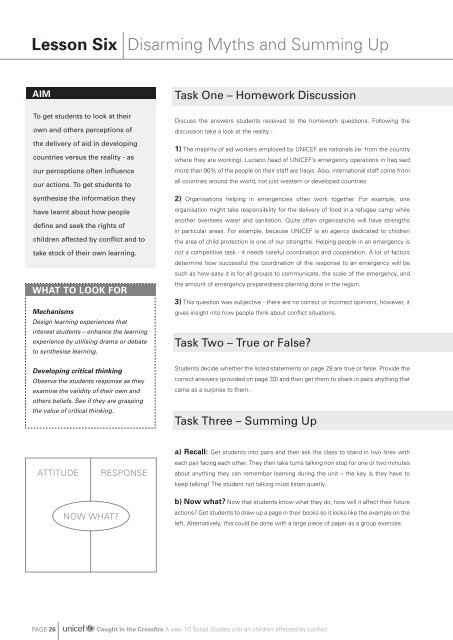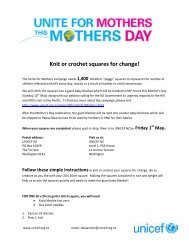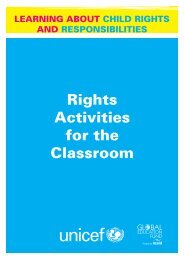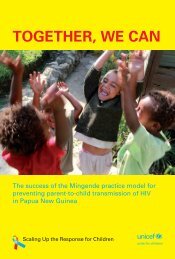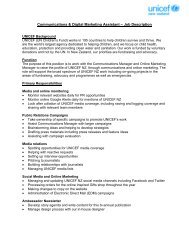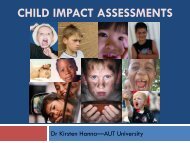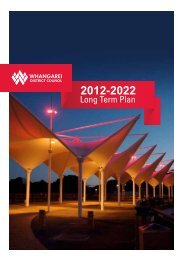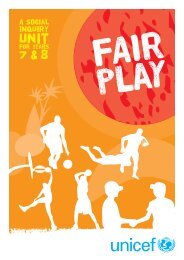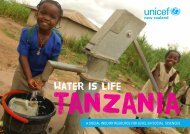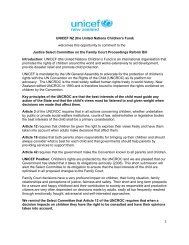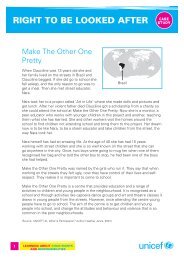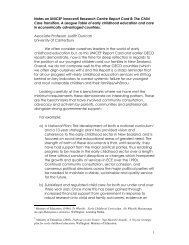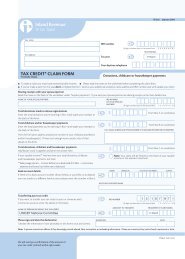Caught in the Crossfire pdf - Unicef
Caught in the Crossfire pdf - Unicef
Caught in the Crossfire pdf - Unicef
You also want an ePaper? Increase the reach of your titles
YUMPU automatically turns print PDFs into web optimized ePapers that Google loves.
Lesson Six Disarm<strong>in</strong>g Myths and Summ<strong>in</strong>g Up<br />
AIM<br />
To get students to look at <strong>the</strong>ir<br />
own and o<strong>the</strong>rs perceptions of<br />
<strong>the</strong> delivery of aid <strong>in</strong> develop<strong>in</strong>g<br />
countries versus <strong>the</strong> reality - as<br />
our perceptions often <strong>in</strong>fluence<br />
our actions. To get students to<br />
syn<strong>the</strong>sise <strong>the</strong> <strong>in</strong>formation <strong>the</strong>y<br />
have learnt about how people<br />
def<strong>in</strong>e and seek <strong>the</strong> rights of<br />
children affected by conflict and to<br />
take stock of <strong>the</strong>ir own learn<strong>in</strong>g.<br />
WHAT TO LOOK FOR<br />
Mechanisms<br />
Design learn<strong>in</strong>g experiences that<br />
<strong>in</strong>terest students – enhance <strong>the</strong> learn<strong>in</strong>g<br />
experience by utilis<strong>in</strong>g drama or debate<br />
to syn<strong>the</strong>sise learn<strong>in</strong>g.<br />
Develop<strong>in</strong>g critical th<strong>in</strong>k<strong>in</strong>g<br />
Observe <strong>the</strong> students response as <strong>the</strong>y<br />
exam<strong>in</strong>e <strong>the</strong> validity of <strong>the</strong>ir own and<br />
o<strong>the</strong>rs beliefs. See if <strong>the</strong>y are grasp<strong>in</strong>g<br />
<strong>the</strong> value of critical th<strong>in</strong>k<strong>in</strong>g.<br />
Task One – Homework Discussion<br />
Discuss <strong>the</strong> answers students received to <strong>the</strong> homework questions. Follow<strong>in</strong>g <strong>the</strong><br />
discussion take a look at <strong>the</strong> reality -<br />
1) The majority of aid workers employed by UNICEF are nationals (ie: from <strong>the</strong> country<br />
where <strong>the</strong>y are work<strong>in</strong>g). Luciano head of UNICEF’s emergency operations <strong>in</strong> Iraq said<br />
more than 90% of <strong>the</strong> people on <strong>the</strong>ir staff are Iraqis. Also, <strong>in</strong>ternational staff come from<br />
all countries around <strong>the</strong> world, not just western or developed countries.<br />
2) Organisations help<strong>in</strong>g <strong>in</strong> emergencies often work toge<strong>the</strong>r. For example, one<br />
organisation might take responsibility for <strong>the</strong> delivery of food <strong>in</strong> a refugee camp while<br />
ano<strong>the</strong>r oversees water and sanitation. Quite often organisations will have strengths<br />
<strong>in</strong> particular areas. For example, because UNICEF is an agency dedicated to children<br />
<strong>the</strong> area of child protection is one of our strengths. Help<strong>in</strong>g people <strong>in</strong> an emergency is<br />
not a competitive task - it needs careful coord<strong>in</strong>ation and cooperation. A lot of factors<br />
determ<strong>in</strong>e how successful <strong>the</strong> coord<strong>in</strong>ation of <strong>the</strong> response to an emergency will be<br />
such as how easy it is for all groups to communicate, <strong>the</strong> scale of <strong>the</strong> emergency, and<br />
<strong>the</strong> amount of emergency preparedness plann<strong>in</strong>g done <strong>in</strong> <strong>the</strong> region.<br />
3) This question was subjective - <strong>the</strong>re are no correct or <strong>in</strong>correct op<strong>in</strong>ions, however, it<br />
gives <strong>in</strong>sight <strong>in</strong>to how people th<strong>in</strong>k about conflict situations.<br />
Task Two – True or False?<br />
Students decide whe<strong>the</strong>r <strong>the</strong> listed statements on page 29 are true or false. Provide <strong>the</strong><br />
correct answers (provided on page 33) and <strong>the</strong>n get <strong>the</strong>m to share <strong>in</strong> pairs anyth<strong>in</strong>g that<br />
came as a surprise to <strong>the</strong>m.<br />
Task Three – Summ<strong>in</strong>g Up<br />
ATTITUDE<br />
RESPONSE<br />
a) Recall: Get students <strong>in</strong>to pairs and <strong>the</strong>n ask <strong>the</strong> class to stand <strong>in</strong> two l<strong>in</strong>es with<br />
each pair fac<strong>in</strong>g each o<strong>the</strong>r. They <strong>the</strong>n take turns talk<strong>in</strong>g non stop for one or two m<strong>in</strong>utes<br />
about anyth<strong>in</strong>g <strong>the</strong>y can remember learn<strong>in</strong>g dur<strong>in</strong>g <strong>the</strong> unit – <strong>the</strong> key is <strong>the</strong>y have to<br />
keep talk<strong>in</strong>g! The student not talk<strong>in</strong>g must listen quietly.<br />
NOW WHAT?<br />
b) Now what? Now that students know what <strong>the</strong>y do, how will it affect <strong>the</strong>ir future<br />
actions? Get students to draw up a page <strong>in</strong> <strong>the</strong>ir books so it looks like <strong>the</strong> example on <strong>the</strong><br />
left. Alternatively, this could be done with a large piece of paper as a group exercise.<br />
PAGE 26<br />
<strong>Caught</strong> <strong>in</strong> <strong>the</strong> <strong>Crossfire</strong> A year 10 Social Studies unit on children affected by conflict


